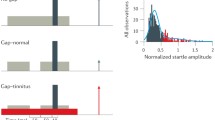Abstract
Scientific evidence has proved reorganisation processes in the auditory cortex after sensorineural hearing loss and overstimulation of certain tonotopic cortical areas, as we see in auditory conditioning techniques. Acoustic rehabilitation reduces the impact of these reorganisation changes. Recent theories explain tinnitus mechanisms as a negative consequence of neural plasticity in the central nervous system after a peripheral aggression. Auditory discrimination training (ADT) could partially reverse the wrong changes in tonotopic representation and improve tinnitus. We discuss different studies and their efficacy on tinnitus perception and annoyance. Indications, method, dose and sound strategy need to be implemented.





Similar content being viewed by others
References
Neuman AC (2005) Central auditory system plasticity and aural rehabilitation of adults. J Rehabil Res Dev 42(4 Suppl 2):169–186. doi:10.1682/JRRD.2005.01.0020
Willot JF (1996) Physiological plasticity in the auditory system and its possible relevance to hearing id use, deprivation effects and acclimatization. Ear Hear 17(3 Suppl):S66–S77
Flor H, Birbaumer N, Braun C et al (1995) Phantom-limb pain as a perceptual correlate of cortical reorganization following arm amputation. Nature 375:482–484. doi:10.1038/375482a0
Rajan R (1998) Receptor organ damage causes loss of cortical surround inhibition without topographic plasticity changes. Nat Neurosci 1:138–143. doi:10.1038/388
Eggermont JJ, Komiya H (2000) Moderate noise trauma in juvenile cats results in profound cortical topographic map changes in adulthood. Hear Res 142:78–84. doi:10.1016/S0378-5955(00)00024-1
Thai-Van H, Micheyl C, Norena A, Collet L (2002) Local improvement in auditory frequency discrimination is associated with hearing loss slope in subjects with cochlear damage. Brain 125:424–437. doi:10.1093/brain/awf044
Robertson D, Irving DRF (1989) Plasticity of frequency organization in auditory cortex of guinea pigs with partial unilateral deafness. J Comp Neurol 282:456–471. doi:10.1002/cne.902820311
Rajan R, Irvine DRF, Wise LZ, Heil P (1993) Effect of unilateral partial cochlear lesions in adult cats on the representation of lessoned and unlessoned cochleas in primary auditory cortex. J Comp Neurol 338:17–49. doi:10.1002/cne.903380104
Schwaber MK, Garraghty PE, Kaas JH (1993) Neuroplasticity of the adult primate auditory cortex following cochlear hearing loss. Am J Otol 14(3):252–258
Eggermont JJ, Roberts LE (2004) The neuroscience of tinnitus. Trends Neurosci 27(11):676–682. doi:10.1016/j.tins.2004.08.010 Review
Dietrich V, Nieschalk M, Stoll W, Rajan R, Pantev C (2001) Cortical reorganization in patients with high frequency cochlear hearing loss. Hear Res 158:95–101. doi:10.1016/S0378-5955(01)00282-9
Mc-Dermott HJ, Lech M, Kornblum MS, Irvine DR (1998) Loudness perception and frequency discrimination in subjects with steeply sloping hearing loss: possible correlates of neural plasticity. J Acoust Soc Am 104(4):2314–2325. doi:10.1121/1.423744
Buss E, Hall JR 3rd, Grose JH, Hatch DR (1998) Perceptual consequences of peripheral hearing loss: do edge effects exist for abrupt cochlear lesions? Hear Res 125:98–108. doi:10.1016/S0378-5955(98)00131-2
Vasama JP, Makela JP (1995) Auditory pathway plasticity in adult humans after unilateral idiopathic sudden sensorineural hearing loss. Hear Res 87:132–140. doi:10.1016/0378-5955(95)00086-J
Recanzone GH, Schreiner CE, Merzenich MM (1993) Plasticity in the frequency representation of primary auditory cortex following discrimination training in adult owl monkeys. J Neurosci 13:87–103
Pantev C, Oostenveld R, Engellen A, Ross B, Roberts LE, Hoke M (1998) Increased auditory cortical representation in musicians. Nature 392(6):811–814. doi:10.1038/33918
Menning H, Roberts LE, Pantev C (2000) Plastic changes in the auditory cortex induced by intensive frequency discrimination training. Neuroreport 11(4):817–822. doi:10.1097/00001756-200003200-00032
Krauss N, McGee T, Carrell TD, King C, Tremblay K, Nicol T (1995) Central auditory system plasticity associated with speech discrimination training. J Cogn Neurosci 7:25–32. doi:10.1162/jocn.1995.7.1.25
Norena AJ, Eggermont JJ (2005) Enriched acoustic environment alter noise trauma reduces hearing loss and prevents cortical map reorganization. J Neurosci 25:699–705. doi:10.1523/JNEUROSCI.2226-04.2005
Norena AJ, Eggermont JJ (2006) Enriched acoustic environment after noise trauma abolishes neural signs of tinnitus. Neuroreport 17(6):559–563. doi:10.1097/00001756-200604240-00001
Gabriel D, Veuillet E, Vesson JF, Collet L (2006) Rehabilitation plasticity: Influence of hearing aid fitting on frequency discrimination performance near the hearing-loss cut-off. Hear Res 213:49–57. doi:10.1016/j.heares.2005.12.007
Muhlnickel W, Elbert T, Taub E, Flor H (1998) Reorganization of auditory cortex in tinnitus. Proc Natl Acad Sci USA 95(17):10340–10343. doi:10.1073/pnas.95.17.10340
Lockwood AH, Salvi RJ, Coad BA et al (1998) The functional neuroanatomy of tinnitus. Neurology 50:114–120
Weisz N, Voss S, Berg P, Elbert T (2004) Abnormal auditory mismatch response in tinnitus sufferers with high-frequency hearing loss is associated with subjective distress level. BMC Neurosci 5:8. doi:10.1186/1471-2202-5-8
Diesch D, Struve M, Rupp A, Ritter S, Hülse M et al (2004) Enhancement of steady-state auditory evoked magnetic fields in tinnitus. Eur J Neurosci 19:1093–1104. doi:10.1111/j.0953-816X.2004.03191.x
Weisz N, Wienbruch C, Dohrmann K, Elbert T (2005) Neuromagnetic indicators of auditory cortical reorganization of tinnitus. Brain 128(Pt 11):2722–2731. doi:10.1093/brain/awh588
Herraiz C, Diges I, Cobo P, Plaza G, Aparicio JM (2006) Auditory discrimination therapy (ADT) for tinnitus management: preliminary results. Acta OtoLaryngol Stockh 126:80–83. doi:10.1080/03655230600895614
Flor H et al (2001) Effect of sensory discrimination training on cortical reorganisation and phantom limb pain. Lancet 357:1763–1764. doi:10.1016/S0140-6736(00)04890-X
Flor H, Hoffmann D, Struve M, Diesch E (2004) Auditory discrimination training for the treatment of tinnitus. Appl Psychophysiol Biofeedback 29:113–120. doi:10.1023/B:APBI.0000026637.77671.f4
Herraiz C, Hernández Calvín FJ, Plaza G et al (2001) Evaluación de la incapacidad en los pacientes con acúfenos. Acta Otorrinolaringol Esp 52:142–145
Herraiz C, Diges I, Cobo P (2007) Auditory discrimination therapy (ADT) for tinnitus management. Prog Brain Res 166:467–471. doi:10.1016/S0079-6123(07)66045-2
Author information
Authors and Affiliations
Corresponding author
Rights and permissions
About this article
Cite this article
Herraiz, C., Diges, I., Cobo, P. et al. Cortical reorganisation and tinnitus: principles of auditory discrimination training for tinnitus management. Eur Arch Otorhinolaryngol 266, 9–16 (2009). https://doi.org/10.1007/s00405-008-0757-y
Received:
Accepted:
Published:
Issue Date:
DOI: https://doi.org/10.1007/s00405-008-0757-y




